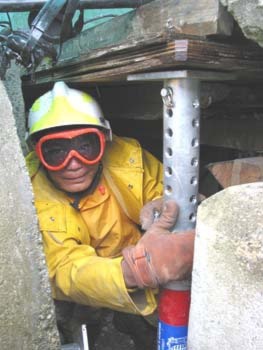Victoria’s Urban Search & Rescue team preps for the big one
Victoria’s ground has never seemed so shaky. With news of the New Zealand earthquakes mirroring our own city’s geographical make-up — both cities have similar structures, quake risk and population size — many have started retuning their dials to emergency preparedness and finding out exactly what Victoria would do under the same situation. Luckily, one Victoria group has had quakes on the brain for some time now and it’s their business to make sure Victoria is as prepared as possible when the shaking starts. Canadian Urban Search and Rescue (USAR) is a nation-wide emergency preparedness network that trains volunteers to act as emergency response teams should a disaster strike. Victoria’s USAR division is currently 21-people strong, but will be bringing on another 10 trained volunteers in the coming weeks. Their goal is to create a 40-person team by the end of the year.“There are very few communities in Canada spending the time and resources to develop teams like this, but we’re very fortunate that we have the City of Victoria’s support in putting funding into this kind of a program,” says Rob Johns, emergency coordinator with the Victoria Emergency Management Agency. The Victoria team has been training for one year, with some of the urban rescue members coming over from wilderness rescue programs. Typically, training takes up to two years, says Johns, with volunteers being expected to attend one Tuesday and one weekend training session per month, indefinitely. Volunteers learn basic skills, like incident command, radio usage, tool techniques and emergency shoring. Right now, Johns says the team is gelling well and is ready to take on “light” search and rescue, which involves efforts surrounding wooden structures. At the end of two years, the team will move up to “medium” designation which means members are equipped to deal with brick structures and small concrete buildings. Whenever an earthquake causes structural damage, an entire team may be needed to search each building. Victoria’s USAR team is one of the first of its kind to be entirely volunteer-driven. But since its classification will max out at medium due to equipment restrictions, the city will always need to call in extra support from “heavy” operational USAR teams that are federally funded. Currently, Canada only has five of these USAR divisions, stationed in Vancouver, Calgary, Manitoba, Toronto and Halifax.“Whether we have 50 or 500 volunteers, we’re always going to have to call for backup … and it’s critical that help comes within the first 48 hours,” says Johns. “Right now, our team couldn’t deal with the kind of disaster they’re seeing in Christchurch [N.Z.].”Johns was in Christchurch last October when an earthquake with a magnitude of five struck. He was in a building at the time, and remembers the whole experience lasting at least 15 seconds.“It’s a surreal experience to be in a building that suddenly starts rocking back and forth with no warning. The way a structure creaks and groans is so unsettling,” says Johns. “After the first few seconds you’re pretty ready for it to be over, but then the aftershocks and the rocking still has to stop.”Christchurch’s most recent tragedy has seen the death toll rising into the hundreds. Johns can still remember the people running into the street last October, hugging and crying, but adds that fleeing the scene is one of the most dangerous things a person can do.“You can’t outrun an earthquake, and it’s often more risky to be outside,” he says. “If you remember the ‘Drop, Cover, Hold’ technique — get to the ground before the earthquake makes you fall, get under a table and hold on — then that’s really the best thing anyone can do.”While it’s easy to start feeling anxious about something so out of our control — and that scientists say is imminent — Johns says there are things that every family can do to ensure preparedness. Namely, talk about it. Create an emergency kit, go over a safety plan, mark a reunification site (in case people are separated and phones are down) and consider taking a course in first aid. “The reality is that we don’t know when an earthquake will hit,” Johns says. “But, in the meantime, we just have to keep moving forward and become as prepared as we can.”For those willing to go a step further and get involved with Victoria’s USAR team, Johns is quick to point out that interested men and women don’t have to be body builders or extreme athletes to become search-and-rescue volunteers — in fact, even small body types have an important role for hard-to-reach places.“You do have to be in good health and have stamina, strength and dexterity,” says Johns. “Mostly, we need people who are excited to be part of the team, but also realize that they may never get called — and, with that high of a time commitment, that can be a hard thing for some people.”Jowett Wong, 31, is one excited volunteer who joined Victoria’s team last year. While Wong has very little background in emergency response, he was thrilled to have an opportunity to give back to the community in such a tangible way.“Once I had a better understanding of what USAR was all about, the risks became more apparent. Through training, you learn that you are taking calculated risks to help someone, but that your primary responsibility is to ensure your own safety and that of your team,” says Wong. “Hopefully [Victoria’s USAR] will inspire other municipalities to create similar programs and increase awareness.”Wong says he is glad for the opportunity to get training no one else would experience, short of becoming a first responder.“You just have to look at the media footage from Christchurch or any earthquake and the look of shock and despair on peoples faces in the aftermath,” says Wong. “I want to be able to help those in need if and when the time comes.” M
